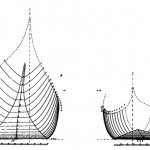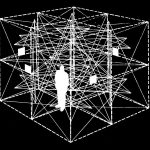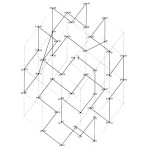Catalan polymath, Ramon Llull was the first person to conceive a device able to externalise the human mind. In his seminal opus, the Ars Magna, Llull conceived a series of figures that could replicate the mental ability to connect information in order to acquire knowledge. Thanks to these studies, he is considered a precursor of artificial intelligence research.
The Llullian figures, a series of instruments that organise and place concepts into relationships, exploit the ability of geometry to produce interconnections on two-dimensional, paper surfaces. They employ lines, concentric shapes, ladders and frames bearing a visual quality similar to that of architectural plans

Ramon Llull’s Ars generalis ultima (“The Ultimate General Art”) or Ars Magna included paper-based devices to create new knowledge out of the connection and combination of different concepts. In the first figure of the Ars Magna, nine equidistant points on a circumference are all connected through equal lines. These lines symbolise the potential of the different attributes written on an outer circumference to be mutually associated. Working as metaphors of multiple paths, the lines symbolise the active role of the different terms and illustrate how they work as a system of relationships and not as static attributes.
The Ars Magna was an instrument intended as a tool to explain the precept of Christian faith to Muslims and thus to convert them to Christianity. However, it revealed an intrinsic potential to work as a “logic machine”, an instrument producing knowledge in different fields through multiple combinations of ideas. Llull constructed the very first demonstration that showed that human way of thinking could be imitated by a device.

One of the main figures to construct knowledge in Llull’s theories is an architectural element, namely the ladder, which visualises the concept of “ascending and descending”. For example, it was intended to symbolise descending from a general principle to a more particular one.


This text is contained in: Mariabruna Fabrizi, Fosco Lucarelli, Database Network Interface. The Architecture of Information, Caryatide, Paris, 2021.





Leave a Reply